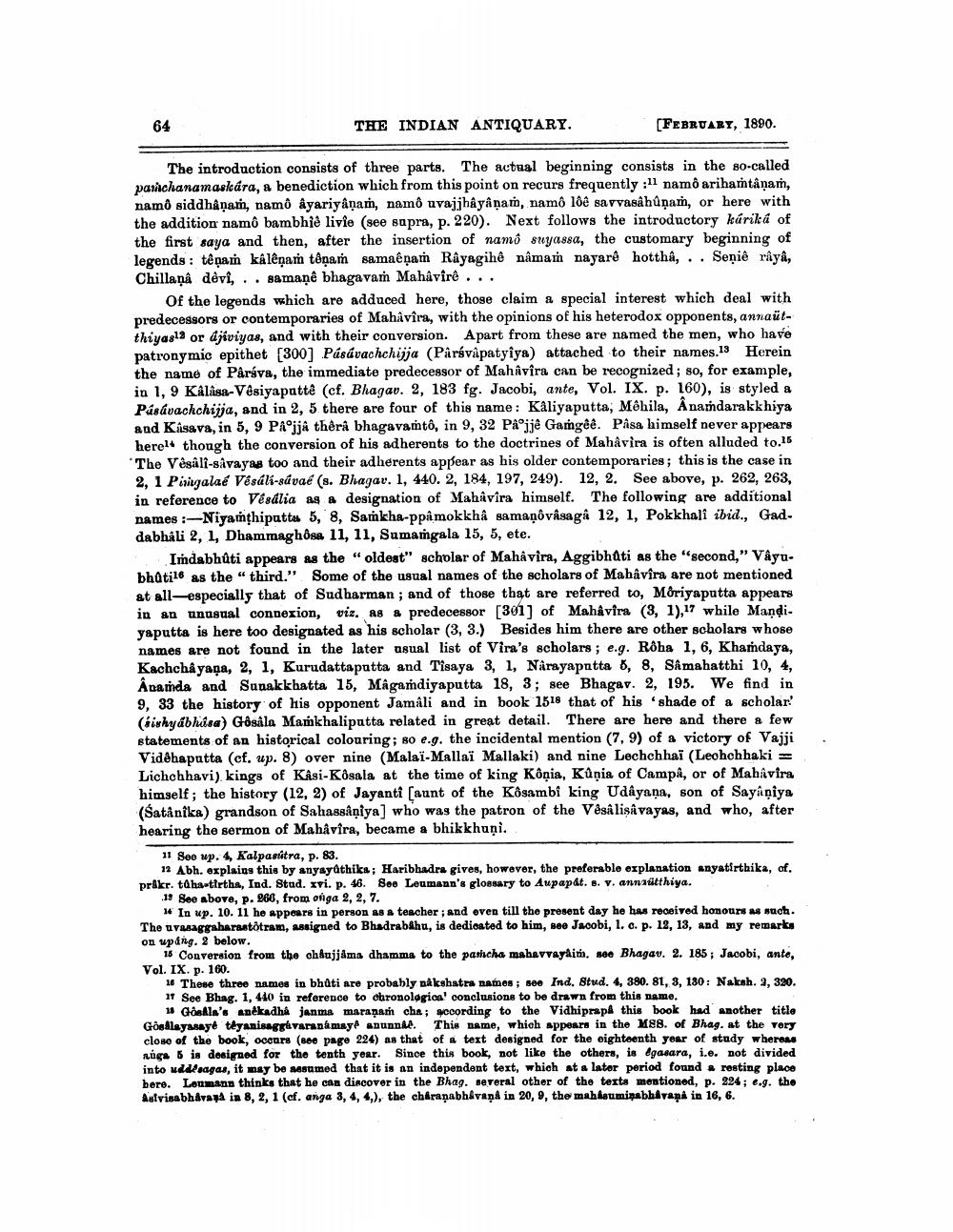________________
THE INDIAN ANTIQUARY.
(FEBRUARY, 1890.
The introduction consists of three parts. The actual beginning consists in the so-called parichanamaskara, a benediction which from this point on recurs frequently :11 namô arihartâņam, namô siddhaņam, namo dyariyâņam, namô uvajjhâyâņam, namo 188 savvaskhúņam, or here with the addition namo bambhie livie (see supra, p. 220). Next follows the introductory kúriká of the first saya and then, after the insertion of namo suyassa, the customary beginning of legends : têņam kalēņam tôņam samaêņam Rayagihê nåmam nayarê hotthá, . . Senie râyâ, Chillana devi, .. samaņê bhagavam Mahaviré...
Of the legends which are adduced here, those claim a special interest which deal with predecessors or contemporaries of Mahâvîra, with the opinions of his heterodox opponents, annaütthiyayla or djiviyas, and with their conversion. Apart from these are named the men, who have patronymic epithet (300) Pásávachchijja (Pårøvâpatyiya) attached to their names.13 Herein the name of Påráva, the immediate predecessor of Mahâvîra can be recognized; so, for example, in 1, 9 Kalasa-Vêsiyapatté (cf. Bhagav. 2, 183 fg. Jacobi, ante, Vol. IX. p. 160), is styled a Pásávachchijja, and in 2, 5 there are four of this name: Kåliyaputta, M@hila, Anamdarakkhiya and Kisava, in 5, 9 PARjjâ thêrá bhagavamtô, in 9, 32 Påojje Gamgêê. Pasa himself never appears herelt though the conversion of his adherents to the doctrines of Mahavira is often alluded to 15 * The Vêsali-savayas too and their adherents appear as his older contemporaries; this is the case in
2, 1 Piringalaé Vésáli-sávaé (s. Bhagav. 1, 440.2, 184, 197, 249). 12, 2. See above, p. 262, 263, in reference to Vésdlia as a designation of Mahavira himself. The following are additional names :-Niyanthipattu 5, 8, Samkha-ppå mokkhå samaņôvâsagâ 12, 1, Pokkhali ibid., Gad. dabhâli 2, 1, Dhammaghôsa 11, 11, Sumamgala 15, 5, ete.
Irndabhůti appears as the oldest" scholar of Mahåvira, Aggibhati as the "second," VÀyu. bhūti16 as the "third." Some of the usual names of the scholars of Mahavira are not mentioned at all-especially that of Sudharman; and of those that are referred to, Möriyaputta appears in an unusual connexion, viz. As a predecessor [301] of Mahavira (3, 1), 17 while Mandi. yaputta is here too designated as his scholar (3, 3.) Besides him there are other scholars whose names are not found in the later usual list of Vira's scholars; e.g. Roha 1, 6, Khamdaya, Kachchâ yaņa, 2, 1, Kurudattaputta and Tisaya 3, 1, Narayaputta , 8, Samahatthi 10, 4, Anamda and Sunakkhatta 15, Magandiyaputta 18, 3; see Bhagav. 2, 195. We find in 9, 33 the history of his opponent Jamali and in book 1518 that of his shade of a scholar' (bishyabhisa) Gôskla Mankhaliputta related in great detail. There are here and there a few statements of an historical colouring; so e.g. the incidental mention (7, 9) of a victory of Vajji Vidêhapatta (ef, up. 8) over nine (Malaï-Mallai Mallaki) and nine Lochchhai (Leohchhaki = Lichchhavi) kings of Kisi-Kösala at the time of king Kônia, Küņia of Campå, or of Mahavira himself; the history (12, 2) of Jayanti [aunt of the Kôsambi king Udâyaņa, son of Sayaniya (Satânika) grandson of Sahassaniya) who was the patron of the Véså lisavayas, and who, after hearing the sermon of Mahavira, became a bhikkhuņi.
11 See wp. 4, Kalpasitra, p. 83.
12 Abh. explains this by anyayathiks; Haribhadra gives, however, the preferable explanation anyatirthika, of. pråkr. taha-tirtha, Ind. Stud. xvi. p. 46. Soe Leumann's glossary to Aupapát... Y. annatitthiya.
19 See above, p. 960, from onga 2, 2, 7.
* In up. 10. 11 he appears in person as a teacher; and even till the present day he has received honours as such. The uvuaggaharastotram, assigned to Bhadrabihu, is dedicated to him, see Jacobi, 1. o. p. 12, 13, and my remarks on upang. 2 below.
18 Conversion from the chlujjama dhamma to the pancha mahavvaylin, so Bhagav. 2. 185; Jacobi, anto, Vol. IX. p. 160.
16 These three names in bhäti are probably nakshatra names; see Ind. Stud. 4, 380.81, 3, 180: Nakah. 2, 320. 11 See Bhag. 1, 440 in reference to chronological conclusions to be drawn from this name.
11 Galla's Anekadha janma marañar cha; according to the Vidhiprap this book had another title GôAlayasayé téyanisarglaramay anunnle. This name, which appears in the M88. of Bhag. att. close of the book, occurs (see page 224) as that of a text designed for the eighteenth year of study wherous niga 6 is designed for the tenth year. Since this book, not like the others, is égasara, i.e. not divided into udelsagas, it may be msumed that it is an independent text, which at a lator period found a resting place bere. Laumann thinks that he can discover in the Bhag. several other of the texts mentioned, p. 224; e.g. the Astvisabhavand in 8, 2, 1 (cf. anga 3, 4, 4,), the charaṇabhavand in 20, 9, the mahkumipabhirapa in 16, 6.




